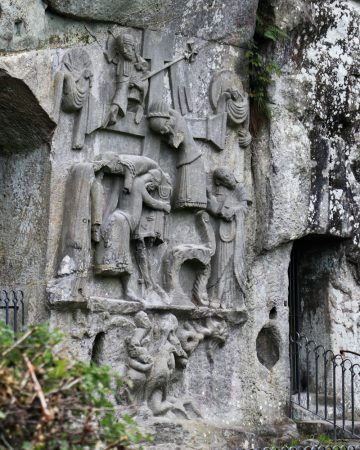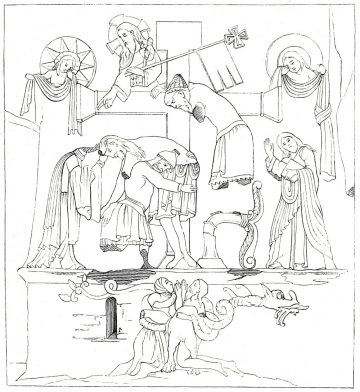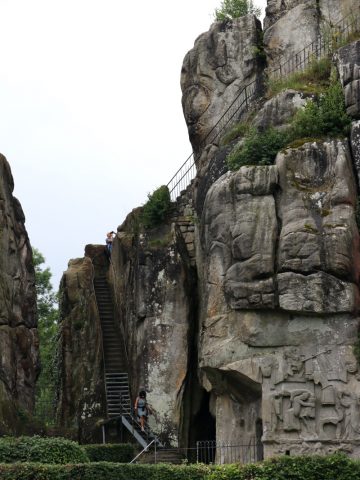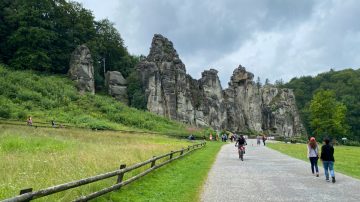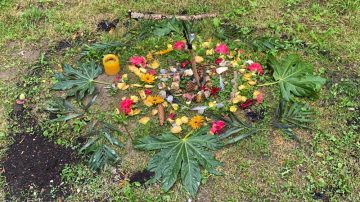The sandstone rock ridge of the Externsteine, often associated with the Saxon pagan irminsul, is a top sight to see in the Teutoburg Forest in Germany.
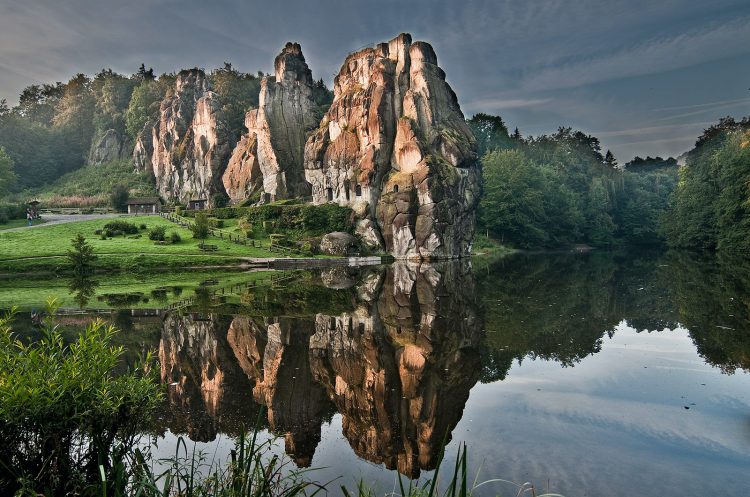
The Externsteine is a row of large rock formations in the Teutoburger Wald near Detmold in the Lippe district of North-Rhine Westphalia. They are particularly noteworthy as there are few other large rocks in this part of Germany. Historically and culturally the stones have been linked to Saxon paganism, the irminsul, Charlemagne, Goethe, German nationalism, and Nazi propaganda. The area of outstanding natural beauty is hugely popular with hikers and cyclists and especially over weekends attracts large numbers of visitors from the population rich cities of Nordrhein-Westfalia. (NRW).
Geology of the Externsteine
The meaning of “Extern” is not entirely clear. X is rarely used in German and various other spellings and names were used in centuries past. The name has been linked to various mythological fantasies but current thinking is that it simply means “pointy rocky ridge”.
Pointy rock ridge describes the Externsteine well. It is a natural sandstone outcropping of a few hundred meters of which only 13 large rocks are visible at the edge of the forest. They are numbered I to XIII starting from the northwest (pond area).
The five more interesting stones are those closest to the pond:
- I. Grottenfels / cave rock — named after the caves inside the rock.
- II. Turmfels / tower rock — seemingly the tallest at 37.5 m (120 ft).
- III. Treppenfels / stairs rock — stairs are attached.
- IV. Wackelsteinfelsen / wobble stone rock — the large stone on top seemed ready to fall off or being pushed onto the enemy at any moment but was fixed tightly with iron hooks during the 19th century.
- V. Ruferfelsen / crier rock — it has a rock like a head calling out at the top.
The geological formation consists of hard sandstone (Osningsandstein) laid down around 100 million years ago when a large lake covered this part of Europe. Thousands of years of erosion weathered the sand and softer stones away until only these rocks remained.
Human Alterations of the Externsteine
Humans have altered the stones for centuries leading to speculation over the use and meaning of the stones to prehistoric men. In addition to the obvious reliefs and other carvings, the caves were made, or at least enlarged, by human effort. In the tower rock, complicated window structures are in line with the summer solstice leading to speculation that it was used as an astrological observatory — a German Stonehenge for those trying to really push the idea far. The stones being a natural phenomenon and not positioned by humans are rarely disputed.
The oldest stair railings are from 1663 but there is evidence of even older fixtures. Climbing the stairs are still popular and the views from the top are grand, at least towards the south. The forest grew so tall that the views to the opposite side are limited.
The rocks, especially inside the caves, have various carvings of humans and animals, but the clearest and most famous is the large relief carving “Descent from the Cross”, which can clearly be seen on the southern side of the rocks. Many of the other reliefs can only be seen when climbing the rocks.
Descent from the Cross Relief
The relief carving Descent from the Cross (Kreuzabnahmerelief an den Externsteinen) is the most interesting of the artwork at the Externsteine. It measures nearly 5 m high by 4 m wide. Current thinking dates it to around 1160 making it the oldest such large relief rock carving north of the Alps.
It was long thought that the relief was Carolingian — an idea that received an extra boost at the start of the 19th-century tourist boom when in 1824 Goethe wrote that he believed it could have been by a monk from the court of Charlemagne — he cleverly used the subjunctive. The natural scientist, Karl Theodor Menke who in the same year correctly attributed the work to the late 12th century was largely ignored for decades.
The basic scene at the center is familiar from Christian art: Nicodemus (to the right of the cross) bends over to help to lower the body of Christ onto the shoulders of Joseph of Arimathea. To the left is Mary, Mother of Christ (the head of this statue was lost), while John the Evangelist is on the far right (with a book).
At the top is God at the center carrying a flag and a small person. It is not clear whether it is Christ that has risen with man or God the Father with his Son. On either side are representations of the sun and moon carrying drapes.
At the bottom are two figures caught in the coils of a dragon. These have been identified as either Adam and Eve trapped by the original sin, or a Saxon warrior and a Christian priest. The latter interpretation links back up to the central scene and the question on what Nicodemus is standing on (despite his now lost legs). A palm tree or another plant bent over? A chair? Or, a bent Saxon irminsul?
History of the Externsteine
Thinking of the Externsteine was influenced for centuries after Hermann Hamelmann claimed in 1564 that the rocks had been a Germanic holy site destroyed by Charlemagne during the suppression of the pagan Saxons. Some claimed it as the location of the irminsul — a sacred pillar-like object venerated by Germanic pagans. Others saw it as a kind of Stonehenge or other pagan holy site. However, scientific research provided very little evidence of such myths, legends, or fantasies.
Although the oldest evidence of a human presence at the Externsteine is from the old stone age (around 10,000 BC) there is no indication of humans actually settling here. Then there is a gap with no evidence of human activity until at least the sixth century AD and most likely several centuries later only.
During the Middle Ages, the rocks were used for Christian ceremonies. The exact details are disputed but it could have been at times a hermitage or an ersatz pilgrimage site for the faithful unable to travel to the Holy Land.
The Lippe family controlled the area from the early 13th century, but after the count of Lippe-Detmold had introduced the reformation all religious activities were banned. During the 17th century his large coat of arms carved into the rock. He erected a pleasure palace next to the Externsteine that was used for entertainment and probably also to control the highway that passed through the rocks between stones III and IV (it was the main road until 1936).
During the 19th century, tourism boomed — the Wiembecke pond was installed for aesthetic reasons. Hotels, restaurants, and even a tram line followed — these were only removed in the mid-20th century with the visitors center and restaurant now out of sight at the parking area.
During the Nazi era, the Ahnenerbe division (ancestral heritage) temporarily drained the pond to dig for evidence of a Germanic cultural site at the Externsteine. Himmler took a personal interest. The few ceramic and metal objects founds are now in the museum in Detmold. However, nothing of a Germanic civilization here was ever discovered with all the ceramics from the medieval or later periods.
Externsteine Visitors’ Information
The area around the Externsteine is always open and admission to the grounds is completely free. The charge to climb the stairs onto the rocks is €4 (€2 for children 6 – 14 years). Buy tickets at the visitors’ center at the parking lot.
The visitors center and restaurant are usually open daily from 10:00 to 18:00 (16:00 in winter). Opening hours of the stairs depend on the season but are usually year-round on weekends and daily during the summer vacations, The stairs are often closed on Monday, Tuesday, and Wednesday. Some of the stairs to the less interesting rocks are freely accessible outside the official opening hours.
The Externsteine is visited by between half a million and a million visitors per year. Many are hikers or cyclists as this is an area of natural beauty within easy reach of the population rich cities of NRW. It is therefore especially busy over weekends and on holidays.
On May 1 and the summer solstice, the area is popular with the esoteric and party groups. Bans on camping, open fires, and alcohol are often imposed with varying degrees of success.
Transportation to the Externsteine
The Externsteine, Externsteiner Str. 33, 32805 Horn-Bad Meinberg, is easiest reached by car. The large parking area has a small charge. The closest town is the very small Horn with Detmold the nearest large town. It is roughly halfway between Bielefeld and Paderborn while Dortmund and Hannover are around 100 km away. Driving on the small country roads is fairly slow but enjoyable due to the natural beauty of the region.
On weekends, from Easter to 1 November, it is possible to reach the Externsteine (and Hermannsdenkmal for example) on the TouristikLinie bus 792 from Detmold — the bus has space for bicycles. The rest of the week use bus 782.
The Externsteine is a popular stop on hiking and cycling trails that include amongst others the Hermannsdenkmal — around 10 km to the north.


